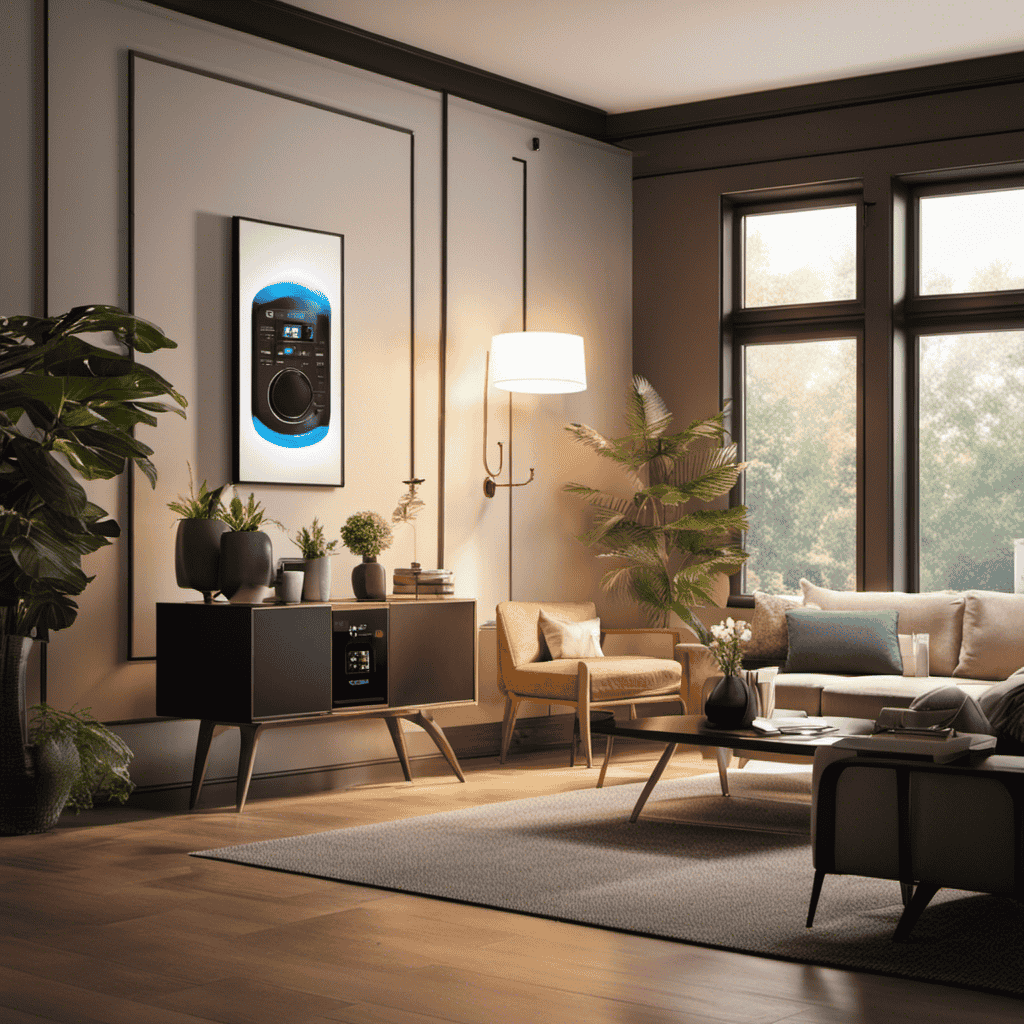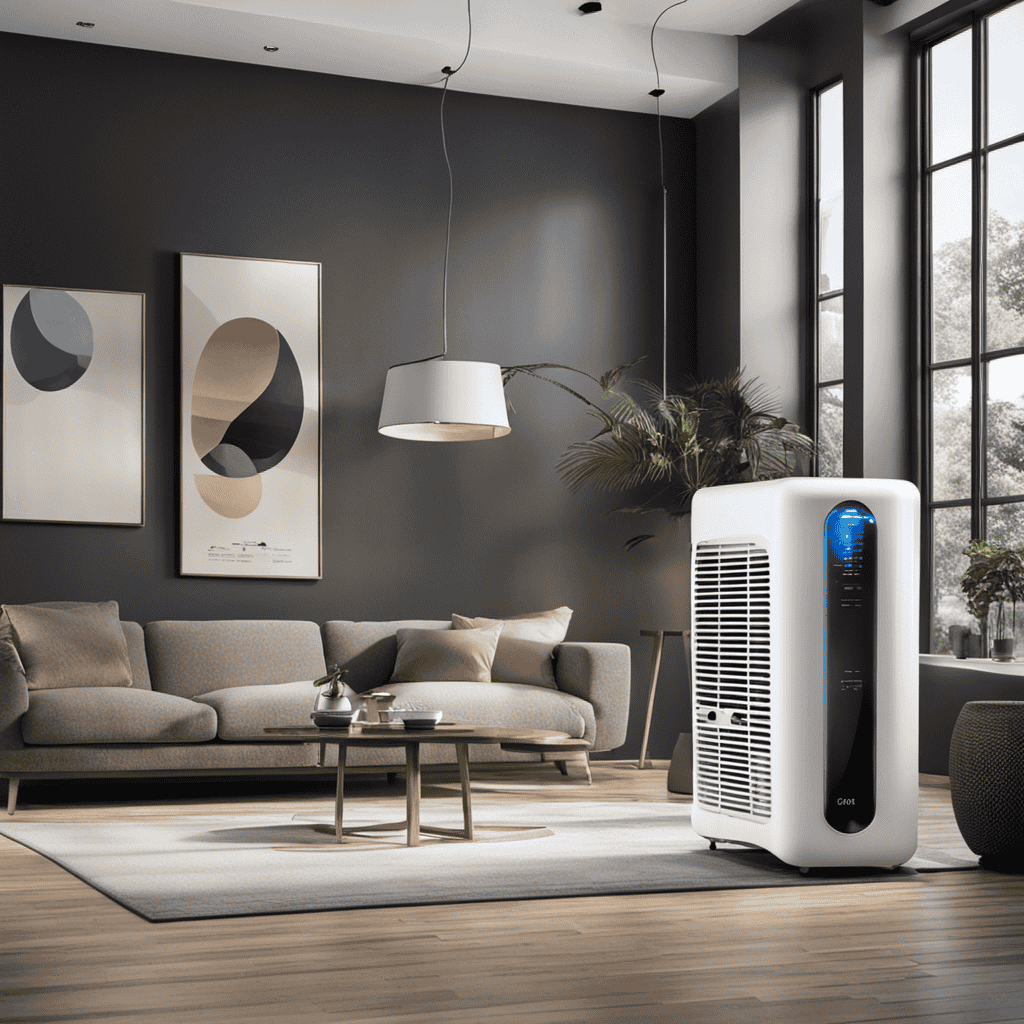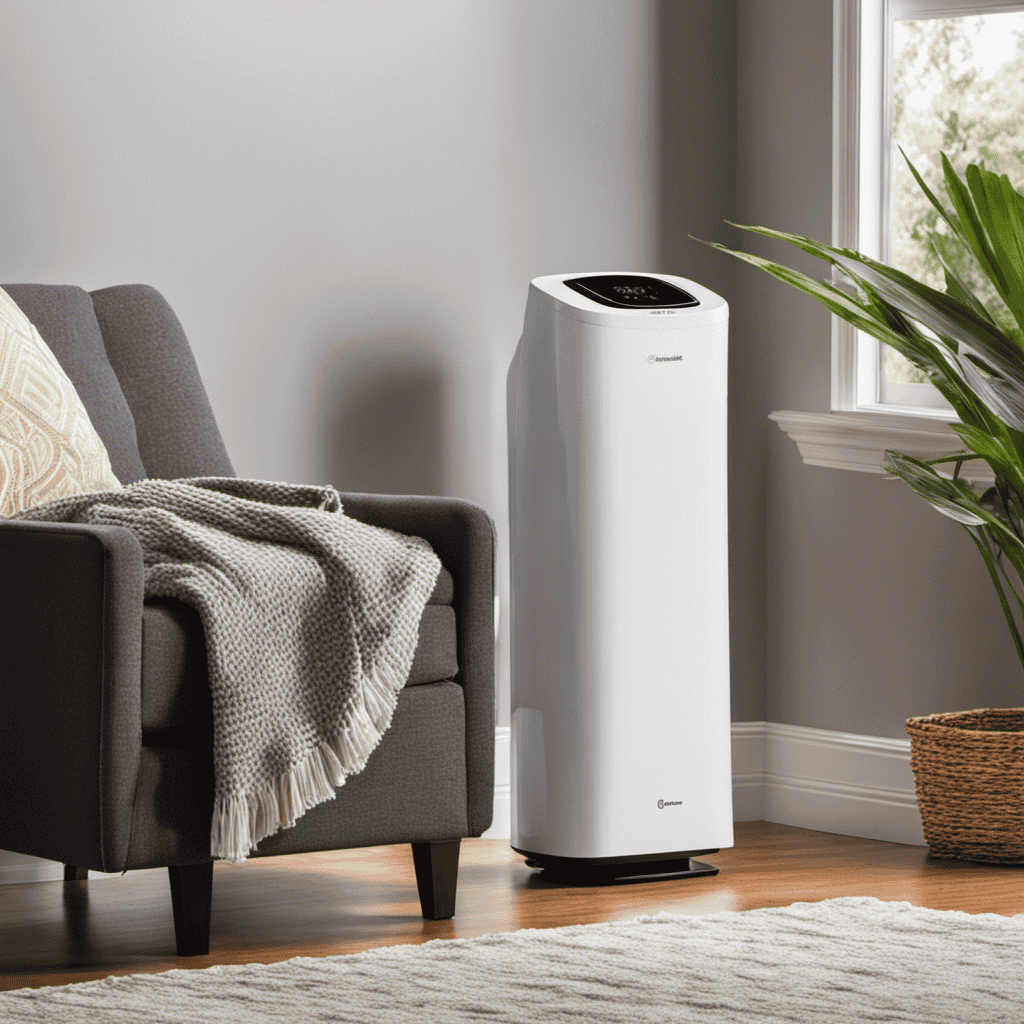Hello there!
Have you ever wondered how much using an air purifier can impact your monthly electric bill? Well, guess what? I’ve got all the answers you need.
In this article, we’ll dive into the factors that affect the energy consumption of air purifiers and explore how different models can vary in their electricity usage. By the end, you’ll have a clear understanding of just how much this handy appliance can affect your wallet.
So, let’s get started!
Key Takeaways
- Fan speed is a main factor affecting energy consumption of air purifiers.
- Choosing air purifiers with adjustable fan speeds and automatic shut-off timers can help reduce energy consumption.
- Look for ENERGY STAR certification on air purifiers as they consume less energy.
- Utilizing energy-saving features and choosing air purifiers with lower energy consumption can reduce electricity usage and minimize the impact on the electric bill.
What Factors Affect the Energy Consumption of Air Purifiers
One of the main factors that affect the energy consumption of air purifiers is the fan speed. The faster the fan speed, the more energy the air purifier will consume. This is because the fan is responsible for drawing air into the purifier and pushing it out after it has been cleaned.
Air purifiers with energy-saving features, such as adjustable fan speeds or automatic shut-off timers, can help reduce energy consumption. By setting the fan speed to a lower setting or using the timer to turn off the purifier when it’s not needed, you can minimize the impact on your overall home energy consumption.
It’s important to consider these energy-saving features when purchasing an air purifier to ensure you’re making a more efficient and environmentally friendly choice.
Understanding the Energy Efficiency Ratings of Air Purifiers
To better understand the energy efficiency ratings of air purifiers, you should familiarize yourself with the different labels and what they mean for your electricity usage. Energy efficiency benefits and energy saving features are important considerations when choosing an air purifier.
Here are three key aspects to look for in the energy efficiency ratings:
-
ENERGY STAR Certification: Look for the ENERGY STAR logo on air purifiers. This certification signifies that the product meets strict efficiency guidelines set by the Environmental Protection Agency. ENERGY STAR certified air purifiers are designed to consume less energy, which can lead to significant energy savings over time.
-
Energy Consumption Ratings: Pay attention to the energy consumption ratings provided by the manufacturer. These ratings indicate the amount of energy the air purifier uses in different settings, such as low, medium, or high fan speeds. Choosing an air purifier with lower energy consumption ratings can help reduce your electricity usage.
-
Power-saving Features: Some air purifiers come with power-saving features, such as timers or sensors that automatically adjust the fan speed based on air quality. These features can help optimize energy usage and ensure that the air purifier operates efficiently without wasting unnecessary power.
Estimating the Average Monthly Cost of Running an Air Purifier
When it comes to energy consumption, it’s important to compare the different options available to determine the most cost-effective choice.
In this discussion, we will explore the energy consumption comparison of various air purifiers and provide some cost-saving tips to help minimize electricity expenses.
Energy Consumption Comparison
If you’re wondering about the energy consumption comparison, using an air purifier may slightly increase your electric bill. However, there are energy-saving features available in some models that can minimize the impact.
Here are three key points to consider:
-
Energy saving features: Many modern air purifiers come with energy-saving features such as programmable timers and auto-shutoff functions. These features allow you to optimize the usage of your purifier, reducing energy consumption when it’s not needed.
-
Noise level comparison: When choosing an air purifier, it’s important to consider the noise level. Some models operate at a higher decibel level, which can be bothersome in quiet spaces. Look for air purifiers with noise reduction technology or adjustable fan speeds to ensure a quieter operation.
-
Energy-efficient units: Look for air purifiers with energy-efficient ratings. These units are designed to consume less electricity while still providing effective air purification.
Considering these factors can help you select an air purifier that meets your needs while minimizing the impact on your electric bill.
Now let’s move on to some cost-saving tips to further optimize your energy usage.
Cost-Saving Tips
Consider implementing these cost-saving tips to optimize your energy usage and reduce expenses.
By adopting energy-saving techniques, you can make a significant impact on your monthly bills. One effective method is to upgrade your appliances to energy-efficient models. According to the U.S. Department of Energy, replacing old appliances with newer, more efficient ones can save you up to $500 per year.
Additionally, adjusting your thermostat can yield substantial savings. Lowering the temperature by just one degree can result in a 3% reduction in energy usage.
Furthermore, utilizing smart power strips can prevent energy vampire devices from consuming unnecessary electricity when not in use.
Implementing these simple changes can lead to substantial cost savings and a more environmentally friendly household.
Does the Size and Type of Air Purifier Impact Electricity Usage
When it comes to air purifiers, the size and type can have a significant impact on electricity usage.
Larger air purifiers are typically more powerful and can consume more energy to operate efficiently.
Additionally, the type of air purifier, such as HEPA or activated carbon, can also affect electricity usage as different technologies have varying energy requirements.
Understanding these factors can help consumers make informed decisions about their air purifier choices and consider the potential impact on their electricity bills.
Size and Electricity Usage
You’ll want to check the size and electricity usage of the air purifier before making a purchase. Here are three important factors to consider:
-
Air purifier size: The size of the air purifier can impact its electricity consumption. Generally, larger air purifiers tend to consume more electricity than smaller ones. This is because larger units have larger fans and filters that require more power to operate efficiently.
-
Energy efficiency: Look for air purifiers with an energy star rating. These models are designed to be more energy-efficient, which means they consume less electricity while still providing effective air purification.
-
Additional features: Some air purifiers come with extra features like programmable timers or sleep modes. These features can help you save electricity by allowing you to set specific operating times or reducing the fan speed during nighttime hours when air quality tends to be better.
Impact of Purifier Type?
If you’re looking to reduce electricity usage, opting for a more energy-efficient air purifier type can make a significant difference. Energy efficiency refers to the ability of an air purifier to effectively clean the air while consuming less power.
Different air purifier types have varying levels of energy efficiency, which directly impacts their power consumption. For example, HEPA (High-Efficiency Particulate Air) filters are known for their high energy efficiency, as they can remove particles as small as 0.3 microns while using minimal power. On the other hand, electrostatic precipitators and ionizers tend to consume more power due to the need for continuous ion generation.
Therefore, when choosing an air purifier, it’s important to consider its energy efficiency to minimize your power consumption and ultimately reduce your electricity bill.
Tips for Reducing the Energy Consumption of Your Air Purifier
To reduce the energy consumption of your air purifier, try using it only in the rooms you spend the most time in. This way, you can optimize its usage and minimize unnecessary energy usage.
Here are three tips to help you reduce energy consumption and improve the performance of your air purifier:
-
Choose the right filter: Selecting the appropriate filter for your air purifier can make a significant difference in its energy efficiency. Look for filters with a high MERV (Minimum Efficiency Reporting Value) rating. These filters can effectively capture particles while allowing for better airflow, reducing strain on the purifier’s motor.
-
Keep the air purifier clean: Regularly cleaning and maintaining your air purifier can ensure that it operates efficiently. Dust and debris can build up on the filters, hindering airflow and increasing energy consumption. Clean or replace the filters as recommended by the manufacturer to keep the air purifier working optimally.
-
Reduce noise levels: Many air purifiers have different fan speed settings. Lowering the fan speed reduces noise levels and also decreases energy consumption. Consider using the lowest fan speed that still effectively cleans the air in your room.
Comparing the Energy Usage of Different Air Purifier Models
When comparing different air purifier models, it’s important to consider their energy usage and efficiency. Energy saving features are a crucial factor to consider when choosing an air purifier.
Some models have features like programmable timers and sleep modes, which help reduce energy consumption. These features allow you to set specific operating hours or automatically adjust the fan speed based on the air quality.
Additionally, it is important to consider noise levels when purchasing an air purifier. Look for models with low decibel ratings, especially if you plan to use the purifier in a bedroom or office where noise can be disruptive.
How to Calculate the Exact Increase in Your Electric Bill From Using an Air Purifier
Calculating the exact impact of an air purifier on your energy bill can be done by determining the wattage of the device and multiplying it by the number of hours it is used each day. To calculate potential savings, consider investing in energy-efficient models that consume less power.
Here are three key factors to consider:
-
Wattage: Look for air purifiers with lower wattage ratings, as they tend to consume less electricity. A lower wattage means lower energy consumption and, ultimately, lower costs.
-
Energy Efficiency Ratings: Check for air purifiers with high energy efficiency ratings, such as Energy Star certified models. These devices are designed to use less energy without compromising performance.
-
Usage Patterns: Assess how often and for how long you plan to use the air purifier. By reducing usage time or opting for a smart air purifier that adjusts power consumption based on air quality, you can further maximize energy savings.
Frequently Asked Questions
Are There Any Health Benefits to Using an Air Purifier, or Is It Solely for Improving Air Quality?
Using an air purifier not only improves air quality but also provides health benefits. It helps remove allergens, dust, and pollutants, reducing the risk of respiratory issues. Additionally, it can be cost-effective in the long run by preventing health problems.
Can I Run an Air Purifier All Day, or Should I Only Use It for Certain Periods of Time?
I can run an air purifier all day, but is it worth the cost? To save on electricity, consider using it in targeted periods or using energy-saving features.
Can Using an Air Purifier Replace the Need for Regular Cleaning and Dusting in the Home?
Using an air purifier can help improve indoor air quality by removing pollutants, but it cannot replace regular cleaning and dusting. While effective, air purifiers complement cleaning efforts rather than replacing them.
Are There Any Specific Maintenance Tasks or Filter Replacements Required for Air Purifiers to Ensure Optimal Energy Efficiency?
When it comes to air purifiers, regular maintenance tasks and filter replacements are crucial for optimal energy efficiency. By keeping up with these tasks, you can ensure that your air purifier is running efficiently and effectively.
Are There Any Potential Side Effects or Risks Associated With Using an Air Purifier for Extended Periods of Time?
Potential risks and long term effects of using an air purifier for extended periods of time should be considered. It is important to research and understand any potential health concerns associated with prolonged exposure to purified air.
Conclusion
In conclusion, after analyzing the factors that affect the energy consumption of air purifiers and understanding their energy efficiency ratings, it is clear that using an air purifier can increase your electric bill. However, the exact increase will depend on the size and type of air purifier you choose.
To minimize energy consumption, consider tips such as using energy-saving modes and regularly cleaning the filters. By comparing different models, you can make an informed decision and find the perfect balance between clean air and energy efficiency.










